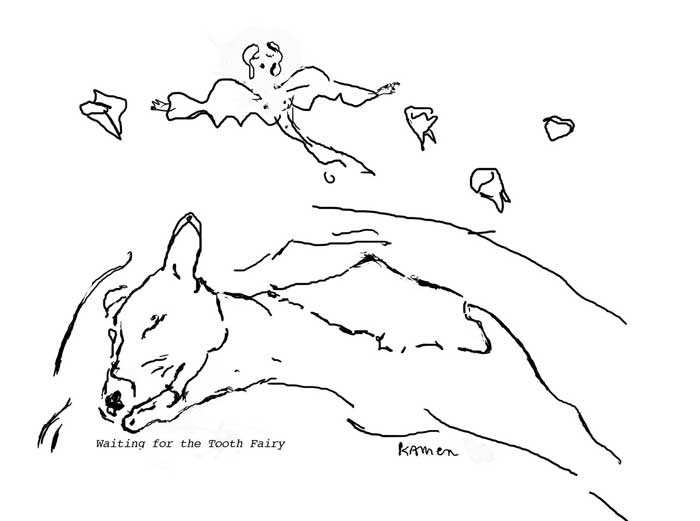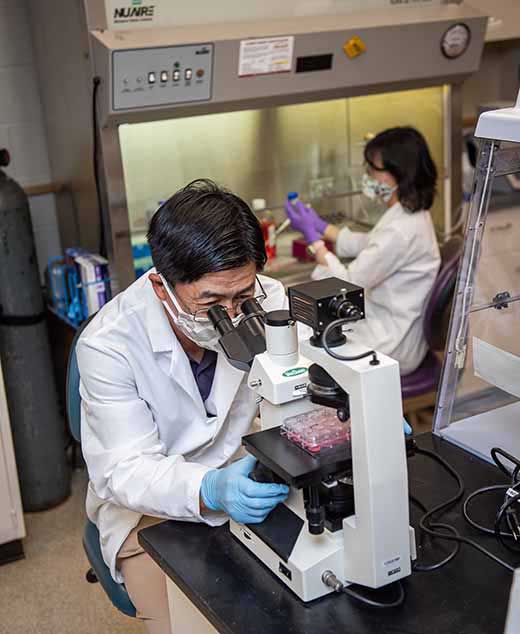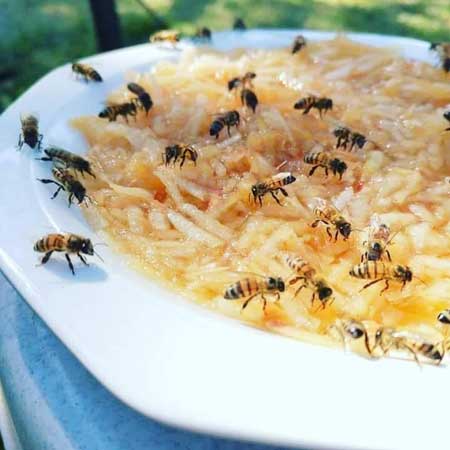Page 10 <previous page > <next page>
SOME HEALTH & SCIENCE NEWS
1. Veterinary virologists find postinfection treatment for SARS-CoV-2.
2. Basenji genome mapped.
3. Dental care, once again.
4. For the bees.
Veterinary virologists find postinfection treatment for SARS-CoV-2
Virologists at K-State say SARS-CoV-2-infected mice treated with a deuterated protease inhibitor show significantly increased survival
https://www.veterinarypracticenews.com/veterinary-virologists-find-postinfection-treatment-for-sars-cov-2/
July 8, 2021 Photo, K-State
 photo by K-State
photo by K-State
A successful postinfection treatment for SARS-CoV-2, the virus that causes COVID-19, may be close at hand.
This is according to team of virologists at Kansas State University’s (K-State’s) College of Veterinary Medicine (CVM). Researchers Kyeong-Ok “KC” Chang, DVM, MS, PhD, and Yunjeong Kim, DVM, PhD, ACVM, have reported findings, showing mice infected with SARS-CoV-2 and then treated with a deuterated protease inhibitor have significantly increased survival and decreased lung viral load.
The results suggest postinfection treatment with inhibitors of proteases essential for viral replication may be an effective treatment against SARS-CoV-2, K-State says. These protease inhibitors are a class of antiviral drugs that prevent viral replication by selectively binding to viral proteases and blocking the activation of proteins necessary for the production of infectious viral particles.
“We developed the protease inhibitor GC376 for treating a fatal coronavirus infection in cats, which is now under commercial development as an investigational new animal drug,” says Dr. Kim, an associate professor of diagnostic medicine and pathobiology at K-State. “After COVID-19 emerged, many research groups reported this inhibitor is also effective against the coronavirus that causes COVID-19, and many are currently pursuing the development of these protease inhibitors as a treatment.”
Kim and Dr. Chang modified GC376 using a tool called deuteration to further increase the efficacy against SARS-CoV-2, K-State reports. Their work shows deuterated GC376 works better for SARS-CoV-2 in lab tests.
“Treating SARS-CoV-2-infected mice with deuterated GC376 significantly improved survival, viral replication in lungs, and weight losses, which shows the efficacy of the antiviral compound,” says Chang, a professor of diagnostic medicine and pathobiology. “The results suggest deuterated GC376 has a potential for further development, and this deuteration method can be utilized to other antiviral compounds to generate more potent inhibitors.”
The virologists are continuing to develop improved inhibitors using various methods, K-State reports. Deuterated GC376 is currently being evaluated for further potential development.
The study, “Postinfection treatment with a protease inhibitor increases survival of mice with a fatal SARS-CoV-2 infection,” has been published in Proceedings of the National Academy of Sciences of the United States of America (PNAS). Access it.
Postinfection treatment with a protease inhibitor increases survival of mice with a fatal SARS-CoV-2 infection.
Significance
Protease inhibitors targeting viral 3C-like protease are attractive therapeutic options for COVID-19. Here, we synthesized deuterated variants of a coronavirus protease inhibitor, GC376, and determined the therapeutic efficacy in a lethal mouse model. The transgenic mice infected with severe acute respiratory syndrome coronavirus 2 (SARS-CoV-2), a causative agent of COVID-19, develop lung pathology resembling that of severe COVID-19 patients and were used for antiviral drug testing. The deuterated variants of GC376 have improved potency against SARS-CoV-2 in in vitro assays. Furthermore, treatment with a deuterated variant starting at 24 h postinfection resulted in significantly increased survival of mice compared to vehicle-treated mice. The results suggest that deuterated variants have excellent potential as antiviral agents against SARS-CoV-2.
https://bmcgenomics.biomedcentral.com/articles/10.1186/s12864-021-07493-6
Chromosome-length genome assembly and structural variations of the primal Basenji dog (Canis lupus familiaris) genome.
Background
Basenjis are considered an ancient dog breed of central African origins that still live and hunt with tribesmen in the African Congo. Nicknamed the barkless dog, Basenjis possess unique phylogeny, geographical origins and traits, making their genome structure of great interest. The increasing number of available canid reference genomes allows us to examine the impact the choice of reference genome makes with regard to reference genome quality and breed relatedness.
Results
Here, we report two high quality de novo Basenji genome assemblies: a female, China (CanFam_Bas), and a male, Wags. We conduct pairwise comparisons and report structural variations between assembled genomes of three dog breeds: Basenji (CanFam_Bas), Boxer (CanFam3.1) and German Shepherd Dog (GSD) (CanFam_GSD). CanFam_Bas is superior to CanFam3.1 in terms of genome contiguity and comparable overall to the high quality CanFam_GSD assembly. By aligning short read data from 58 representative dog breeds to three reference genomes, we demonstrate how the choice of reference genome significantly impacts both read mapping and variant detection.
Conclusions
The growing number of high-quality canid reference genomes means the choice of reference genome is an increasingly critical decision in subsequent canid variant analyses. The basal position of the Basenji makes it suitable for variant analysis for targeted applications of specific dog breeds. However, we believe more comprehensive analyses across the entire family of canids is more suited to a pangenome approach. Collectively this work highlights the importance the choice of reference genome makes in all variation studies.
Dental Care Is Preventative Care – Even for Companion Dogs
March 5, 2021 / General Health / By Hemopet
We get it. Brushing your companion dog’s teeth is not the most pleasant activity.
We also get it that routine veterinary dental cleanings done properly can be expensive. To dispel any myths, dental cleanings are NOT a ploy by veterinarians to increase their revenue.
Both practices – brushing your dog’s teeth and routine dental cleanings – are important preventative care, as periodontal disease in all species can lead to many other systemic disorders, if not controlled.

Ivan Lorin reaching for the toothbrush.
How do you know brushing and dental cleanings are preventative care? From published and ongoing research.
Research has shown that periodontal disease in dogs is linked to increased risks of liver disease, chronic kidney disease, diabetes, obesity, heart disease and even cancer in dogs.
A 2009 study compared 59,296 dogs with periodontal disease to the same number of dogs with no history of periodontal disease. The study revealed that cardiovascular conditions such as endocarditis and cardiopathy were linked to the severity of periodontal disease.
A similar comparative study from 2011 demonstrated a significant association between periodontal disease and chronic kidney disease.
Compared to humans, dogs are even more prone to periodontal disease. Why? Because their mouths are less acidic, which promotes plaque formation. Compounding that, many dogs are not having daily brushings, or regular preventive dental care starting in early adulthood.
If you think your dog is in the clear, look at the prevalence. According to the United States Department of Agriculture (USDA), more than 80% of dogs over 2 years of age have periodontal disease. Additionally, many dogs with periodontal disease do not express oral pain, although they often have foul smelling breath.
Preventative Measures
Yes; there are specially designed chews, treats and raw bones, as well as a variety of Veterinary Oral Health Council (VOHC) approved dental products, that can help reduce plaque and tartar buildup. While these products are not replacements for a daily brushing and dental cleanings, the VOHC listed products are proven to be helpful in reducing the biofilm buildup and plaque on the teeth.
A practical choice is the VOHC-approved water additives and gel products that are specially designed for dogs and cats.
By the way, we do not recommend using rawhide chews at all.
Products
We, at Hemopet, do not recommend or suggest specific products. To be completely transparent, Dr. Dodds has helped with the testing of products that meet and have been accepted by the VOHC.
If anything, we recommend that you make sure the product you choose is an accepted product by VOHC. Products have to meet certain requirements and complete dental trials to meet VOHC’s rigorous standards.
Do we use and prefer all of the VOHC-accepted products? No, but, please remember that the VOHC program requires companies to demonstrate that their products help control plaque or tartar by completing two trials that are reviewed in support of this claim. We support the standards, thresholds and testing protocols established by the VOHC.
References
Glickman, Lawrence T et al. “Association between chronic azotemic kidney disease and the severity of periodontal disease in dogs.” Preventive veterinary medicine vol. 99,2-4 (2011): 193-200. doi:10.1016/j.prevetmed.2011.01.011.
Glickman, Lawrence T et al. “Evaluation of the risk of endocarditis and other cardiovascular events on the basis of the severity of periodontal disease in dogs.” Journal of the American Veterinary Medical Association vol. 234,4 (2009): 486-94. doi:10.2460/javma.234.4.486.

Sometimes there are fewer flowers and other sources of food for the bees.
Water can be scarce and many bees drown as they try and drink from swimming pools.
Grate an apple and add some water in a bowl. The bees will be able to get the sugars from the fruit and drink the water and not drown as they can stand on the fruit pieces.
Our bee populations are threatened, let's give them all the support we can.